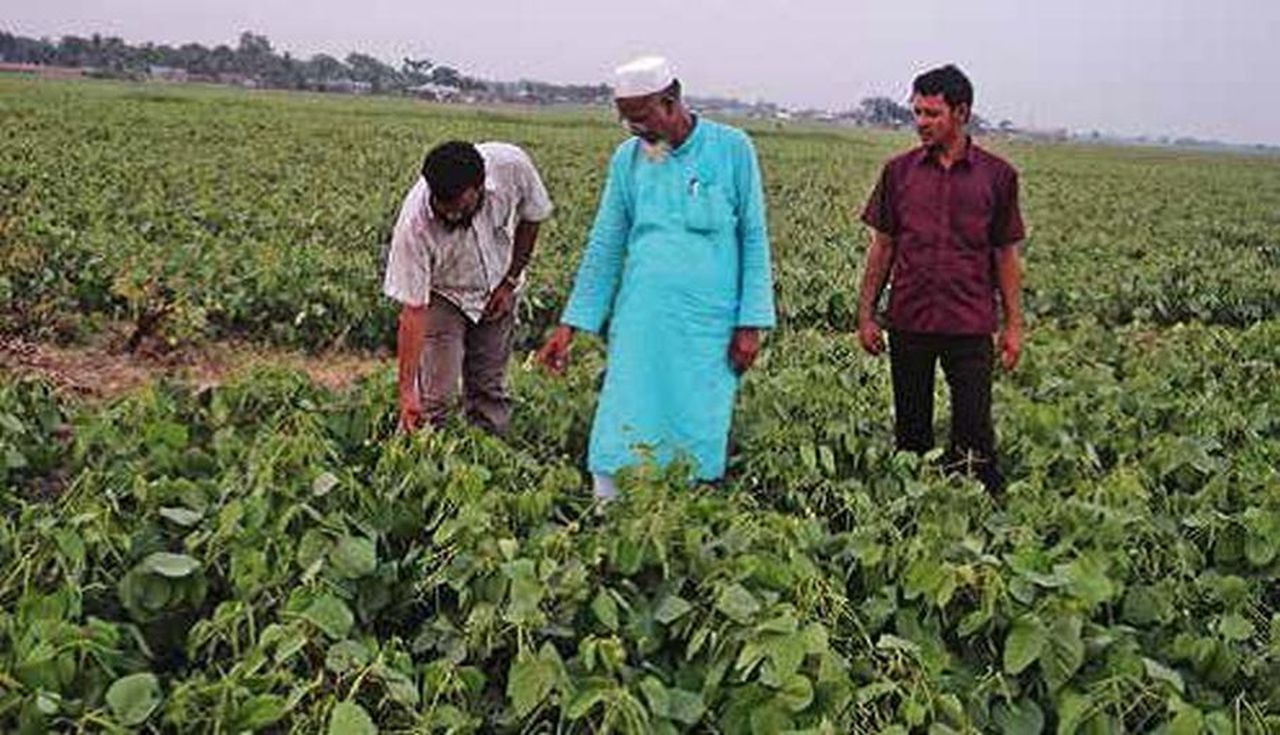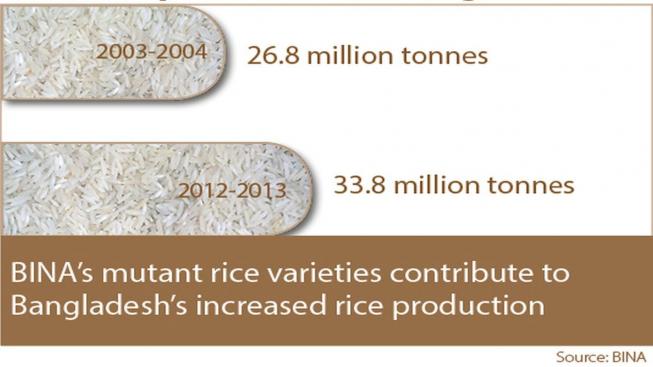Villages in the northern region of Bangladesh used to struggle with poverty and hunger during the long months of the ‘monga’ periods, but they are now bustling as farmers and workers harvest new crop varieties developed using nuclear techniques.
“‘Monga’ is a Bengali word meaning ‘starvation,’” explained Mirza Mofazzal Islam, Principal Scientific Officer and Head of the Biotechnology Division at the Bangladesh Institute of Nuclear Agriculture (BINA). It is used to describe the time between mid-September and mid-November and from March to April, when “there is no work for the farm workers. They suffer; they are foodless,” said Mofazzal Islam.
Conventional rice crops take approximately 140 to 150 days to ripen, which results in long gaps between harvests, and increases the risks of crop damage due to diseases, hailstorms and drought, explained A. H. M. Razzaque, BINA’s Director General. A mutant rice variety produced by BINA with IAEA support using nuclear techniques (see box) has higher yields and shorter maturation periods of 110 to 120 days, allowing 30 to 35 extra days to grow other crops and vegetables.
With this variety, “farmers are now going for winter vegetables, pulses and oil seeds, then going again for another rice crop. So the whole period is occupied by crops, enhancing farming activity and increasing cropping intensity,” Razzaque said. This has increased the income of farmers, including women, and it has also contributed to Bangladesh’s approximately 26 per cent increase in rice production since 2003, Razzaque noted.
In the north-western part of Bangladesh, a region not affected by monga, new mutant varieties have also helped farmers facing harsh environmental conditions. “The livelihood of the farmers has changed with the new [mutant] varieties, especially mung bean and lentil varieties,” said Mohammad Faridul Islam, a farmer from the village Ishurdi. “Now I can fulfil the needs of my family; my two daughters are going to college. I can now buy better foods and clothes. Last year, I also bought farm land to increase my farm, as well as built my new house. My family no longer complains about their needs. They are happy.”
Coastal farmers are facing an entirely different problem, Razzaque said. More than one million hectares of land are affected by saline soil conditions and degradation and are unfit for cultivation using traditional crops. There are now two inbred varieties that are more saline-tolerant, and by replacing traditional varieties with BINA varieties, 40 to 50 per cent of these fallow lands can be cultivated, Razzaque explained. “But we need more saline-tolerant varieties in order to keep the land cultivated year-round,” he emphasized.
Preparing for climate change
Climate change is exacerbating the country’s environmental conditions, causing more saline water to enter normal soil, untimely rainfalls that lead to flooding and an increased number of areas with severe drought, said Razzaque.
“The government is pushing us to have good, sustainable mutant varieties to face the coming climate change issues,” said Mofazzal Islam. “That is why we are keenly aware of the importance of nuclear technology in developing such varieties so that we are prepared to combat the effects of the changing climate on agricultural development.”
With the IAEA’s support through training and fellowships, expert visits, human resources and laboratory development, and the provision of equipment since 1971, BINA has been able to develop new mutant crop varieties. The Institute has developed over 59 varieties using nuclear technology and 23 varieties of 12 different crop species using marker-assisted and other breeding techniques. With the many varieties, “we can address farmers’ needs and problems, and now hopefully the increasing demand,” Mofazzal Islam said.
“Once you fill your stomach, the question comes to quality,” Razzaque said. The demands are rising as farmers and the Government are becoming interested in different qualities and more nutritious crop varieties, fortified with zinc and iron, he said. “We have severe health problems in Bangladesh with zinc and iron deficiencies, particularly for lactating mothers and young kids. If they lack these micronutrients during pregnancy, after birth, they can suffer from other diseases and disabled children can be born.”

